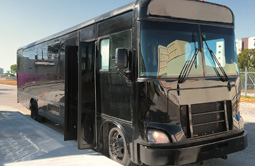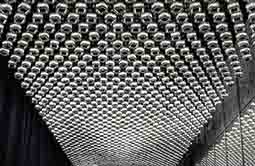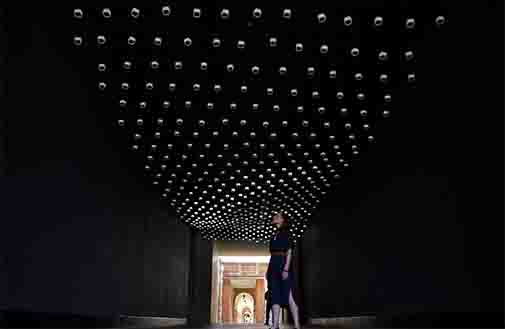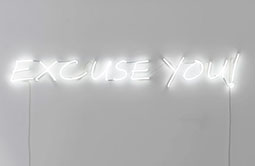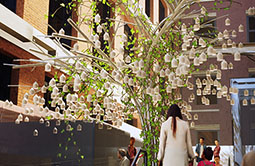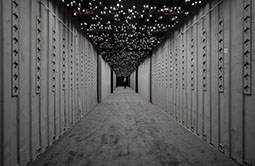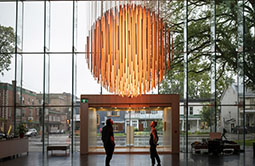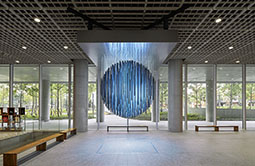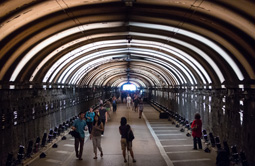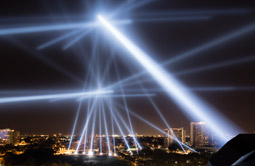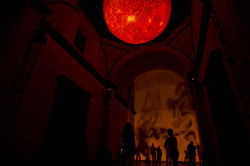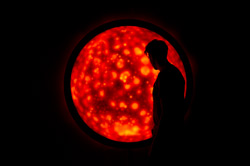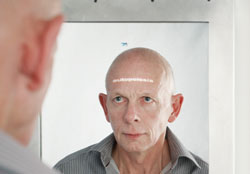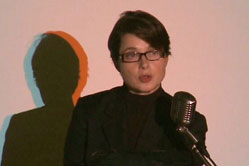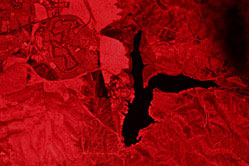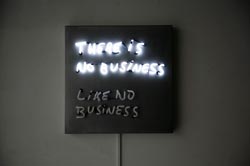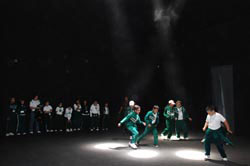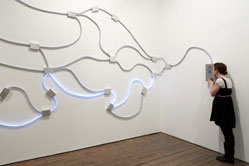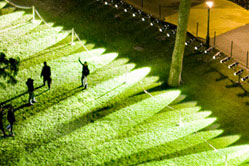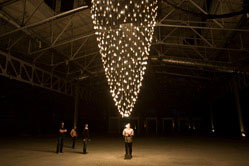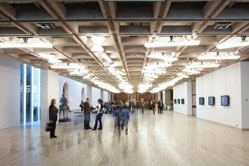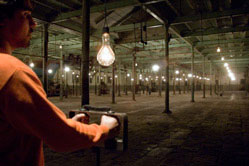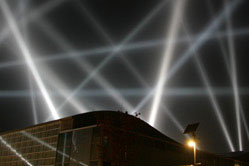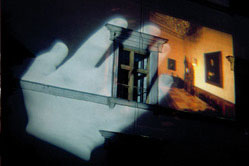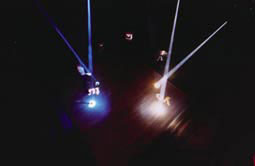Dark Ride
2024
“Dark Ride” was a sound-art performance originally conceived for Laumeier Sculpture Park in St-Louis. The piece was intended as a “social sculpture” to remedy the lack of public transport that could bring visitors from segregated and disadvantaged areas of metropolitan St Louis, Ferguson for example, to Laumeier Park, situated in the city’s affluent suburbs. During the free ride, passengers in the darkened bus would listen to a geolocated and performed soundtrack that changed for every trip.
View details.
View details.
Pulse Voronoi
2024
One cubic metre of crystal explodes into 7,000 unique but complementary shards, expelled in all directions. "Pulse Voronoi" proposes a walk through the resulting cloud of crystals, shortly after the blast. The crystals are suspended in the room, each with a warm light that glimmers rhythmically to the recorded heartbeat of a different participant from the past. Five pulse sensors placed around the room detect visitors' heartbeats which can be heard in the room and seen in surrounding lights. Every new recording of vital signs deletes the oldest one, creating a memento mori.
View details.
View details.
Kristallstimmen
2024
An interactive installation for Swarovski’s “Crystal Worlds Museum” in Wattens, Austria, features an array of 3,000 suspended loudspeakers, each clad in hundreds of small black crystals that get illuminated when in use. As visitors traverse the space, sensors detect their presence and turn on the speaker directly above them, which lights up and plays a voice message. Each loudspeaker contains a recording from a different company employee from around the world, speaking in their native language about their relationship to crystal, with over 100 languages represented. When no visitor is present, the installation is silent.
View details.
View details.
Climate Parliament
2024
“Climate Parliament” is an interactive sound and light installation featuring thousands of audio channels playing on small, custom-made loudspeakers, suspended under the ceiling of a semi-outdoor passageway at Rice University. The speakers are hung out of reach of passers-by in a regular, but staggered formation that creates semi-circular archways with a six-foot radius.
View details.
View details.
EXCUSE YOU!
2022
A collaboration with poet Leigh Kotsilidis, "EXCUSE YOU!" is an indignant yet playful neon sign. A timely calling out. An affable chastising. A snarky apology on your behalf. A provocation for self-reflection. A chance for absolution. EXCUSE YOU! is the figurative finger pointing at all of us, saying: own and apologize for your shit because it's about time!
View details.
View details.
Pulse Topology
2021
“Pulse Topology” uses remote photoplethysmography (PPG) technology, developed to detect heartbeats without using touch. The biometric data collected from participants is used to illuminate 3,000 to 10,000 suspended light bulbs, creating an immersive audio-visual experience which forms a connective topography of the pulses of participants.
View details.
View details.
Speaking Willow
2020
“Speaking Willow” is a sound sculpture in the shape of a weeping willow tree, between 16 and 20 feet high, which adorns the entrance of the Planet Word Museum. The tree sculpture is fabricated in aluminum and is hollow, except the trunk and branches carry inside data cables that emerge from the structure and hang vertically, slowly swaying with the wind. The tree is covered by living vine, Ivy or other evergreen climbing plants that warm-up the design.
View details.
View details.
Field Atmosphonia
2020
“Field Atmosphonia” is a sound and light environment featuring 3,000 audio channels playing on custom-made speakers with LED lights. The project is a soundscape that comes in waves of complex polyphonies that emerge from the array of field recordings.
View details.
View details.
Border Tuner / Sintonizador Fronterizo
Relational Architecture 23, 2019
"Border Tuner" is a large-scale, participatory art installation designed to interconnect the cities of El Paso, Texas, and Ciudad Juárez, Chihuahua. Powerful searchlights make “bridges of light” that open live sound channels for communication across the US-Mexico border. The piece creates a fluid canopy of light that can be modified by visitors to six interactive stations, three placed in El Paso and three in Juárez.
View details.
View details.
Remote Pulse
2019
“Remote Pulse” is an interactive installation consisting of two identical pulse-sensing stations that are interconnected over the internet. When a person places their hands on one station automatically the person on the other station feels their pulse, as the plates vibrate in sync with the heartbeat of the remote person, and vice versa. The piece was originally presented as part of Lozano-Hemmer’s “Border Tuner” installation across the US-Mexico border.
View details.
View details.
Linear Atmosphonia
2019
“Linear Atmosphonia” is a sound environment featuring 3,000 audio channels playing on separate custom-made speakers with LED lights. The piece can be presented as a tunnel or room, and the recordings change typology gradually along the field of speakers: recordings include wind, water, fire, ice, over 200 types of insects, over 300 types of birds, bells, metronomes, bombs and so on. The project results in waves of complex polyphonies that emerge from the array of field recordings.
View details.
View details.
Volumetric Solar Equation
2018
“Volumetric Solar Equation” is a large-scale spherical volumetric display that simulates the varying turbulences, flares, and spots visible on the surface of the sun. Animated by mathematical equations and the latest imagery from NASA’s solar observatories, the content is dynamic and ever-changing, based on live rather than looped video simulations. The chandelier is three metres in diameter and made of 25,580 LED lights on 342 battens.
View details.
View details.
Blue Sun
2018
Blue Sun is a spherical chandelier that represents the turbulence, flares, and spots visible on the surface of the sun using the hottest colours in the spectrum: blue and white. Animated by mathematical equations and the latest imagery from NASA’s solar observatories, the content is dynamic and ever-changing, based on live rather than looped video simulations. The piece draws equal inspiration from scientific visualization and traditions of geometric abstraction in contemporary art.
View details.
View details.
Colorimètre
2017
The interactive installation, “Colorimètre” is a feature wall adorned with over 500 colour panels, arranged in a vertical grid orientation, showcasing a constantly-changing gamut of colours. These colour cells are activated by the colours captured by a camera in the grand hall and its surroundings.
View details.
View details.
External Interior
2015
"External Interior" is an inside-out disco ball made with 1600 one-way mirrors mounted on a transparent acrylic sphere, reminiscent of both Julio Le Parc’s mirrored sculptures and the tessellated vision present in insects with compound eyes. The piece is suspended from pulleys and has a counterweight so that it can be raised and lowered easily. As visitors introduce their head inside the sphere, they see a mise en abyme reflection multiplied kaleidoscopically, creating both a spacious, yet isolated, self-centered experience. Meanwhile, from the outside, the public can clearly see the person inside the sphere.
View details.
View details.
Pulse Corniche
Relational Architecture 22, 2015
“Pulse Corniche” (Relational Architecture 22) was an interactive canopy of powerful light beams projected into to the sky by robotic searchlights whose brightness and orientation was controlled by the heart-rate of visitors to the Abu Dhabi’s Corniche. People were free to participate by holding a sensor placed in the centre of the plaza that converted the electrical activity of their heart into a unique lighting sequence. The intensity and direction of the lights visualized the different biometric rhythms of each participant, in an urban scale.
View details.
View details.
Voice Tunnel
Relational Architecture 21, 2013
“Voice Tunnel” (Relational Architecture 21) was an installation designed to transform the Park Avenue Tunnel in New York City with 300 theatrical spotlights that produce glimmering arches of light along the tunnel’s walls and ceiling. Participants control the intensity of each light by speaking into an intercom at the tunnel’s center which records their voice and loops it. Louder speech increases the lights’ brightness proportionally, creating a Morse-like code of flashes throughout the tunnel. The individual voices can be heard as pedestrians walk through the tunnel, on 150 loudspeakers, one beside each light arch and synchronized with it. At any given time, the tunnel is illuminated by the voices of the past 75 participants: as new participants speak into the intercom, older recordings get pushed away by one position down the array of light fixtures until they leave the tunnel, so that the content of the piece is changing constantly.
View details.
View details.
Airborne Newscasts
Relational Architecture 20, 2013
"Airborne Newscasts" (Relational Architecture 20) is an interactive installation originally commissioned by the Chrysler Museum of Art to transform Norfolk, Virginia’s public space into a poetic shadow play. By blocking the light of two projectors, participants cast their shadows onto a 900-square-metre wall, and these shadows are tracked by computerized surveillance systems. Out of the shadows emanate billowing smoke which is mapped onto the wall, slowly accumulating within it. Turbulent clouds of live newscasts evaporate from the “heat” of the tracked bodies.
View details.
View details.
Open Air
Relational Architecture 19, 2012
“Open Air” (Relational Architecture 19) was an interactive artwork that allowed participants’ voices to transform the sky over Philadelphia. Using a website or a free iPhone app participants could record a voice message and listen to and rate other entries. The messages were played-back over the Benjamin Franklin Parkway using 24 powerful robotic searchlights that reacted, both in brightness and position, to the voice’s frequency and volume as well as to the phone's GPS location.
View details.
View details.
Voice Array
Subsculpture 13, 2011
In “Voice Array” (Subsculpture 13), as a participant speaks into an intercom, his or her voice is automatically translated into flashes of light and then the unique blinking pattern is stored as a loop in the first light of the array. Each new recording pushes all previous recordings one position down and gradually one can hear the cumulative sound of the 288 previous recordings. The voice that was pushed out of the array can then be heard by itself.
View details.
View details.
Nave Solar
2011
“Nave Solar” is an interactive installation featuring a fake Sun that is activated by the pendular motion of the public as they hang from a rope and swing along the nave of a 16th Century catholic inquisition church. Using tracking systems, the installation detects the motion of participants and generates smoke that accumulates on the ceiling of the apse as well as activates the Sun's flares, surface turbulence and sun spots.
View details.
View details.
Articulated Intersect
Relational Architecture 18, 2011
"Articulated Intersect" (Relational Architecture 18) is a large-scale installation that produces an interactive canopy of light that can be modified by the public using six large lever-controllers that protrude from the ground. As a participant points one of these levers three powerful robotic searchlights automatically intersect in the sky to create an apex at that location. The participant may direct the apex anywhere over the city in real-time, creating an animated tetrahedron inspired by the work of Richard Buckminster Fuller.
View details.
View details.
Flatsun
2011
“Flatsun” is a circular display that simulates the turbulence at the surface of the Sun using mathematical equations. The piece reacts to the presence of the public by varying the speed and type of animation displayed. If no one is in front of the piece the turbulence slows down and eventually turns off. As the built-in camera detects people, more solar flares are generated and the fake Sun shows more perturbation and activity. At 140 cm diameter, “Flatsun” is exactly a billion times smaller than the real Sun.
View details.
View details.
Autopoiesis
2010
When people look at themselves in this small mirror they see the word "Autopoiesis" projected on their forehead. The concept of self-creation described by Chilean biologists Maturana and Varela is an inspiration for all art that depends on participation to exist.
View details.
View details.
Solar Equation
Relational Architecture 16, 2010
"Solar Equation" is a large-scale public art installation that consists of a faithful simulation of the Sun, 100 million times smaller than the real thing. Commissioned by the Light in Winter Festival in Melbourne, the piece features the world’s largest spherical balloon, custom-manufactured for the project, which is tethered over Federation Square and animated using five projectors. The solar animation on the balloon is generated by live mathematical equations that simulate the turbulence, flares and sunspots that can be seen on the surface of the Sun. This produces a constantly changing display that never repeats itself, giving viewers a glimpse of the majestic phenomena that are observable at the solar surface and that only relatively recent advances in astronomy have discovered. Using an iPhone, iPod touch or iPad, people may disturb the animations in real-time and select different fluid dynamic visualizations.
View details.
View details.
Levels of Nothingness
Performers 1, 2009
"Levels of Nothingness" is an installation-performance commissioned for the 50th Anniversary of the Guggenheim Museum, inspired by Kandinsky's opera, "The Yellow Sound" (1912). In "Levels of Nothingness", the human voice is analyzed by computers, automatically controlling a full rig of Rock-and-Roll concert lighting and creating an interactive colour show. For the New York performances, Isabella Rossellini read a libretto co-written by Brian Massumi, which included seminal philosophical texts on skepticism, color and perception, including writings by Kandinsky, Deleuze, Sanches, Simon Baron-Cohen and Alexander Luria. Following the performances, audience members could test the color-generating microphone.
View details.
View details.
Navier-Stokes
2009
"Navier-Stokes" is a series of computer-controlled lightboxes that show satellite pictures of border regions that have a vector of economic disparity, a history of military conflict or heavy migratory traffic. Instead of using regular white fluorescent light tubes to illuminate the print, the pieces have over one hundred thousand light emitting diodes (LEDs), which can highlight tiny features within the image. The first piece shows the Tijuana-San Diego border with Mexico illuminated red by default while the US is dark.
View details.
View details.
There Is No Business Like No Business
2009
“There is No Business Like No Business” is a blinking neon sign, designed during the recession as a cruel beacon of optimism. The blinking speed is directly proportional to the trading volume of any commodity index chosen by the collector or curator, say NASDAQ or Apple or FTSE100. In a slow day, or when the market is closed, the lines of illuminated text will only switch every 8 seconds, while on the busiest trading day they may blink every 2 seconds.
View details.
View details.
Voz Alta
Relational Architecture 15, 2008
"Voz Alta" (Loud Voice)(Relational Architecture 15) is a memorial commissioned for the 40th anniversary of the student massacre in Tlatelolco. Participants who speak into a megaphone automatically control the brightness of four searchlights that relay their voice over Mexico City as quiet light flashes; tuning into 96.1FM radio allows people anywhere in the city to listen in live to what the lights are saying.
View details.
View details.
Apostasis
2008
An interactive installation featuring powerful robotic searchlights that create static columns of light in a dark room. When someone tries to walk into a light beam, a computer automatically moves the searchlight so that the beam is pointed somewhere else on the room. A video tracking system observes the room and makes sure that the lights are always illuminating empty spaces where there is no one. People may continually attempt to enter the spotlight but the system will adapt to ensure this can never be achieved.
View details.
View details.
Less Than Three
2008
"Less than Three" is an interactive installation of light strips that form a network between two intercoms. As a participant speaks into an intercom, their voice is translated into corresponding flashes of light and this light pattern is transmitted visually along one of the several possible pathways through the network. When it reaches the other side, the viewer's phrase is once again released as sound. Several voices can be carried simultaneously and the short contributions going fast through the network and the longer ones taking longer.
View details.
View details.
Pulse Park
Relational Architecture 14, 2008
"Pulse Park" (Relational Architecture 14) is comprised of a matrix of light beams that grazed the central oval field of Madison Square Park, New York City. The intensity of each spotlight is entirely modulated by a sensor that measures the heart rate of participants. The resulting effect is a visualization of the body's vital signs, arguably our most symbolic biometric, at an immense scale and in an urban setting.
View details.
View details.
Pulse Spiral
2008
"Pulse Spiral" is a three-dimensional spiral paraboloid made up of 400 lightbulbs arranged according to Fermat's equations, which records and responds to the heart rate of participants who hold a sensor underneath. Commissioned for the opening of the Center for Contemporary Culture in Moscow in the constructivist Bakhmetevsky Bus Garage, the piece is inspired by engineer Vladimir Shukov who worked with Melnikov on this emblematic building from 1926-28.
View details.
View details.
Pulse Front
Relational Architecture 12, 2007
"Pulse Front" (Relational Architecture 12) was an interactive light installation over Toronto's Harbourfront Centre, consisting of a matrix of light beams from twenty powerful robotic searchlights controlled by a network of sensors that measured the heart rate of passers-by. Ten metal sculptures detected and measured the pulse of people who held them and their readings were immediately converted into light pulses and also determined the orientation of the beams.
View details.
View details.
Sustained Coincidence
Subsculpture 8, 2007
"Sustained Coincidence" (Subsculpture 8) is an interactive installation activated by the spatial relationships of visitors within a gallery. The piece consists of a series of incandescent lightbulbs that light up in reaction to the participants’ positions, in such a way that the shadows cast on the opposing wall are always overlapping. The piece is inspired by the phantasmagorias on the one hand and surveillance and digital analysis on the other.
View details.
View details.
Homographies
Subsculpture 7, 2006
"Homographies" (Subsculpture 7) is a large-scale interactive installation featuring a turbulent light array that responds to the movement of the public using a surveillance tracking system. The installation consists of white fluorescent light tubes hung from robotic fixtures on the ceiling of the exhibition space, equally spaced. Each light tube rotates slowly using a computerized stepper motor and create labyrinthine patterns of light that make "paths" or "corridors" between people. All lights are always on and typically constitute the only lighting in the exhibition hall, except for the natural light that spills into the space.
View details.
View details.
Pulse Room
2006
"Pulse Room" is an interactive installation featuring one to three hundred clear incandescent light bulbs, 300 W each and hung from a cable at a height of three metres. The bulbs are uniformly distributed over the exhibition room, filling it completely. An interface placed on a side of the room has a sensor that detects the heart rate of participants. When someone holds the interface, a computer detects his or her pulse and immediately sets off the closest bulb to flash at the exact rhythm of his or her heart.
View details.
View details.
Entanglement
Subsculpture 6, 2005
"Entanglement" (Subsculpture 6) is an interactive installation that consists of two identical neon signs, each measuring 182 x 38 cm. The signs simply state the word "Entanglement", a term used in quantum physics to describe the strange property exhibited by two particles that behave as one. The two signs are connected and do not work independently, turning on and off together by way of a basic light switch, even if the entangled pair is in different cities and in separate rooms.
View details.
View details.
Amodal Suspension
Relational Architecture 8, 2003
“Amodal Suspension" (Relational Architecture 8) is a large-scale interactive installation in which people send short text messages to each other using a cell phone or web browser. However, rather than being sent directly, the messages are encoded as unique sequences of flashes with twenty robotically-controlled searchlights, not unlike the patterns that make up Morse code. Messages "bounce" around from searchlight to searchlight, turning the sky into a giant switchboard.
View details.
View details.
Vectorial Elevation
Relational Architecture 4, 1999
"Vectorial Elevation" (Relational Architecture 4) is an interactive art project originally designed to celebrate the arrival of the year 2000 in Mexico City's Zócalo Square. The website www.alzado.net enabled any Internet user to design light sculptures over the city's historic centre, with eighteen searchlights positioned around the square. These searchlights, whose powerful beams could be seen within a 15 kilometers radius, were controlled by an online 3D simulation program and visualised by digital cameras. A personalised webpage was produced for every participant with images of their design and information such as their name, dedication, place of access and comments.
View details.
View details.
Displaced Emperors
Relational Architecture 2, 1997
"Displaced Emperors" (Relational Architecture 2) was an interactive installation that used an "architact" —architecture meets haptics— interface to transform the facade of the Habsburg Castle in Linz, Austria. Wireless 3D sensors calculated where participants pointed to on the façade and a large animated projection of a hand was projected at that location. As people on the street "caressed" the building, they could reveal the interiors of the Habsburg residence in Mexico City, Castillo de Chapultepec.
View details.
View details.
The Trace
1995
"The Trace" is a telepresence installation that invites two participants in remote sites to share the same telematic space. The piece consists of light vectors, sounds and graphics that respond to the movement of the participants. Two interactive stations are needed for the piece; these are interconnected with a normal ISDN digital line so they can be in the same exhibition hall, on either side of a city or in different cities.
View details.
View details.
